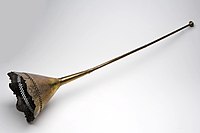This article needs additional citations for verification. (December 2022) |
 Moroccan brass nafīr. Length 110 centimeters, before 1978. | |
| Brass instrument | |
|---|---|
| Other names | būq al-nafīr[1] nefir (Turkish spelling) |
| Classification | Brass |
| Hornbostel–Sachs classification | 423.121 (Natural trumpets – There are no means of changing the pitch apart from the player's lips; end-blown trumpets – The mouth-hole faces the axis of the trumpet.) |
| Inventor(s) | Earliest known are Egyptian. Greek and Etruscan trumpets from antiquity passed through Romans to Persians. Possibly a Middle East Assyrian tradition as well. |
| Developed | Persian Empire and Arab conquerors spread instrument to India, China, Malaysia, Africa and Andalusia. Wars between Europe and Islamic powers brought horn to Europe. Europeans changed horn by bending it into compact forms, which reinfluenced Islamic world. |
| Related instruments | |
|
Straight tube Bent tube
| |
| Sound sample | |
|
| |
Nafir (Arabic نَفير, DMG an-nafīr), also nfīr, plural anfār, Turkish nefir, is a slender shrill-sounding straight natural trumpet with a cylindrical tube and a conical metal bell, producing one or two notes. It was used as a military signaling instrument and as a ceremonial instrument in countries shaped by Islamic culture in North Africa, the Middle East and South Asia. In Ottoman, Persian and Mugulin miniatures, the nafīr is depicted in battle scenes. In Christian culture, it displaced or was played alongside of the curved tuba or horn, as seen in artwork of about the 14th century A.D.
Similar straight signal trumpets have been known since ancient Egyptian times and among the Assyrians and Etruscans. After the fall of the Roman Empire, the straight-tubed Roman tuba continued to flourish in the Middle East among the Sassanids and their Arabic successors. The Saracens, whose long metal trumpets greatly impressed the Christian armies at the time of the Crusades, were ultimately responsible for reintroducing the instrument to Europe after a lapse of six hundred years. The straight trumpet type, called añafil in Spanish, also entered medieval Europe via medieval al-Andalus.
From the Middle Ages to the early 20th century, the nafīr and the straight or S-curved, conical metal trumpet kārna belonged to the Persian military bands and representative orchestras (naqqāra-khāna), which were played in Iran, India (called naubat) and were common as far as the Malay Archipelago (nobat).[2] In the later Ottoman military bands (mehterhâne), the straight nafīr was distinguished from the twisted trumpet boru in which the straight tube was bent into a loop, influenced by such European instruments as the clarion.
The instruments retain ceremonial functions today in Morocco (nafīr played in the month of Ramadan), Nigeria (kakaki played in Ramadan), and Malaysia (as a representative instrument of the sultanates the silver nafiri in the nobat orchestra). Its cousin the Karnay is similarly used in Iran, Tajikistan Uzbekistan and Rajistan, and the Karnal in Nepal.
- ^ Cite error: The named reference
GroveBuqwas invoked but never defined (see the help page). - ^ Geeti Sen (1 January 1979). "Music and Musical Instruments in the Paintings of the Akbar Nama". Library Artifacts. 8 (4).
the paintings of the Akbar Nama...these illustrations confirm the fact that the naqqarakhana was intended to refer to a musicians' gallery, assigned to a specific place in Mughal architecture...[pages 2-3]...to indicate the ritual progression of time through the hours of a day [page 1]...scenes of court festivity. Rites of births and marriage are invariably accompanied with a specific role assigned to the musicians of the naqqarakhana [page 4]...these same instruments of royalty were carried into the battlefield
© MMXXIII Rich X Search. We shall prevail. All rights reserved. Rich X Search
